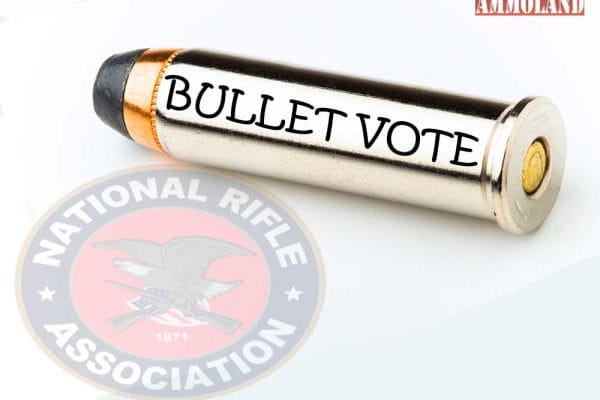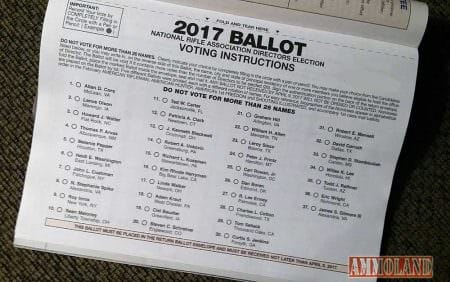Gun activist Jeff Knox explains the process and purpose of NRA Board Bullet Voting.

As various National Rifle Association magazines containing ballots for the NRA Board of Directors Election begin arriving in people’s mailboxes in mid to late February (if you get a ballot, you’re eligible to vote; if you don’t, you probably aren’t).
There’s a lot of talk about the value of one vote, and the mechanics of the NRA ballot. I won’t discuss who is the best candidate but how to make sure your vote is as effective as possible in support of your favorite candidates for the board.
Voting in NRA elections is weighted. Each voter has, in essence, 25 votes (sometimes a few more, if there are seats that were vacated during the term), but you can still give only one to any given candidate. Using all 25+ votes lessens the value of each vote somewhat. Voting for only a few candidates increases the impact of those few votes. Let me explain.
NRA Board Bullet Voting
True “Bullet Voting” means voting for a single candidate instead of casting votes for a full slate of 25+ candidates. Voting for only two or three candidates is a less powerful variation of Bullet Voting, but still leverages your votes. As you look at your ballot, understand that many of the candidates will easily win election or reelection without your help, and there are rarely more than 4 or 5 seats “in play” during any election cycle.
Any vote you cast for someone who might be in contention for one of those seats – other than your favorite – has the potential to help that candidate bump your favorite out of contention.
The NRA uses a simple system that counts the votes cast for each candidate. If there are 25 seats up for election, the 25 candidates with the highest vote totals get those seats. Since there are always more than 25 candidates running, voting for a full slate invariably boosts the chances that another candidate will get more votes than your favorite, and your favorite might be left out of the running. Just one vote difference can cost a seat.
There are 76 seats on the NRA Board of Directors. Each year, 25 seats are up for election to a 3-year term, and one seat is filled for a 1-year term by a vote of members present at the Annual Meeting. There might also be a seat or two that came open due to a Director resigning or dying in office. Most seats will be filled by incumbents being reelected. Typically almost all current Directors are renominated, meaning voters generally have a selection of 24 or 25 incumbents and 4 or 5 new candidates, running to fill the 25 available seats, and all of the incumbents almost always win reelection. There might be one or two open seats up for grabs, or an incumbent or two might be vulnerable. With Bullet Voting, you ensure you’re not boosting the chances of candidates you like less at the expense of your favorites.
Bullet Voting Example
Imagine a typical Director election with 25 incumbent candidates running for 25 seats, along with 3 additional candidates nominated by the Nominating Committee and another 4 candidates nominated by petition of the members. Say you want the 4 petition candidates to win, but there are a few other candidates you like.
Here are your choices:
- You can vote for those 4 petition candidates along with the 4 or 5 other candidates you like, then finish out your ballot with votes for the 18 or so additional candidates that look best to you.
- You can vote for the 4 petition candidates along with the 4 or 5 other candidates you like, and stop there, submitting your ballot with only 4 to 9 candidates marked.
- You can vote for just the 4 petition candidates and leave your other favorites to chance.
- You can vote for just one or two of the petition candidates that you like the best.
The majority of NRA voters will follow the instructions in the full-page ad that’s always right before the ballot and vote for 25 candidates from the list of Nominating Committee nominees – guaranteed. It’s also guaranteed that big name celebrities will always win seats, just because of name recognition.
If you vote as in scenario 1. your additional votes will add to the vote totals of those 18 or so fill-in votes, effectively helping to raise the bar that your favorites need to win seats, makin git harder for them.
If you vote as in scenario 2. your additional votes for the 4 or 5 other candidates could also help edge out your favorite candidates, especially if your additional choices are candidates that are not well known and are likely to come in toward the bottom of the popular voting.
If you vote as in scenario 3. you are giving votes only to your 4 favorites, and not giving any votes to any of their competition, giving your favorites better odds of making the cut and winning seats.
And if you vote as in scenario 4. (a true Bullet Vote) you’re giving that candidate a better chance of winning a seat, possibly at the cost of the other 3 petition candidates.
It is an embarrassment that the greatest political action organization in the country generally gets participation from only 5% to 7% of their members eligible to vote, but that’s the case. This is because the vast majority of members eligible to vote don’t feel that they know the candidates well enough to cast an intelligent ballot. An associated problem is that they think they have to pick a full slate of 25 or 26 candidates, but in reality, they can pick as few as one.

If you are a voting member of NRA, pick the one, two, or five candidates that you think would do the best job on the Board of Directors, and let your voice be heard by voting – whether a single Bullet Vote or a shotgun approach – your opinion matters and can help steer your organization.
What ever you do, don’t vote for more candidates than there are seats being elected, as this will cause your entire ballot to be thrown out. Also, be sure to use the provided ballot envelope and don’t forget to sign it. Failing to do either of these will also get your ballot tossed.
Finally, you can make a huge difference in any election by talking with friends who are also eligible to vote and encouraging, or even helping them, to cast their ballot. Almost 2 million ballots are never returned in NRA elections, and activating even a small percentage of those can make a huge difference in the election results.
Jeff Knox is the director of The Firearms Coalition and an NRA Endowment member.
About Jeff Knox:
Jeff Knox is a second-generation rights activist and director of The Firearms Coalition. His writing can regularly be seen in Firearms News and Front Sight magazines as well as here on AmmoLand Shooting Sports News and other publications.
Founded in 1984 by legendary hero of the rights movement and Jeff’s dad, Neal Knox, The Firearms Coalition represents hundreds of grassroots organizations, clubs, and individual Second Amendment activists around the country. The Coalition has been behind the scenes in the forefront of the fight for rights for over 32 years, with Jeff serving as managing director of the organization since 2005.
To learn more about The Firearms Coalition or to subscribe to their newsletter, the Hard Corps Report, visit their website at www.FirearmsCoalition.org.
from https://ift.tt/dMicaFB
via IFTTT

No comments:
Post a Comment